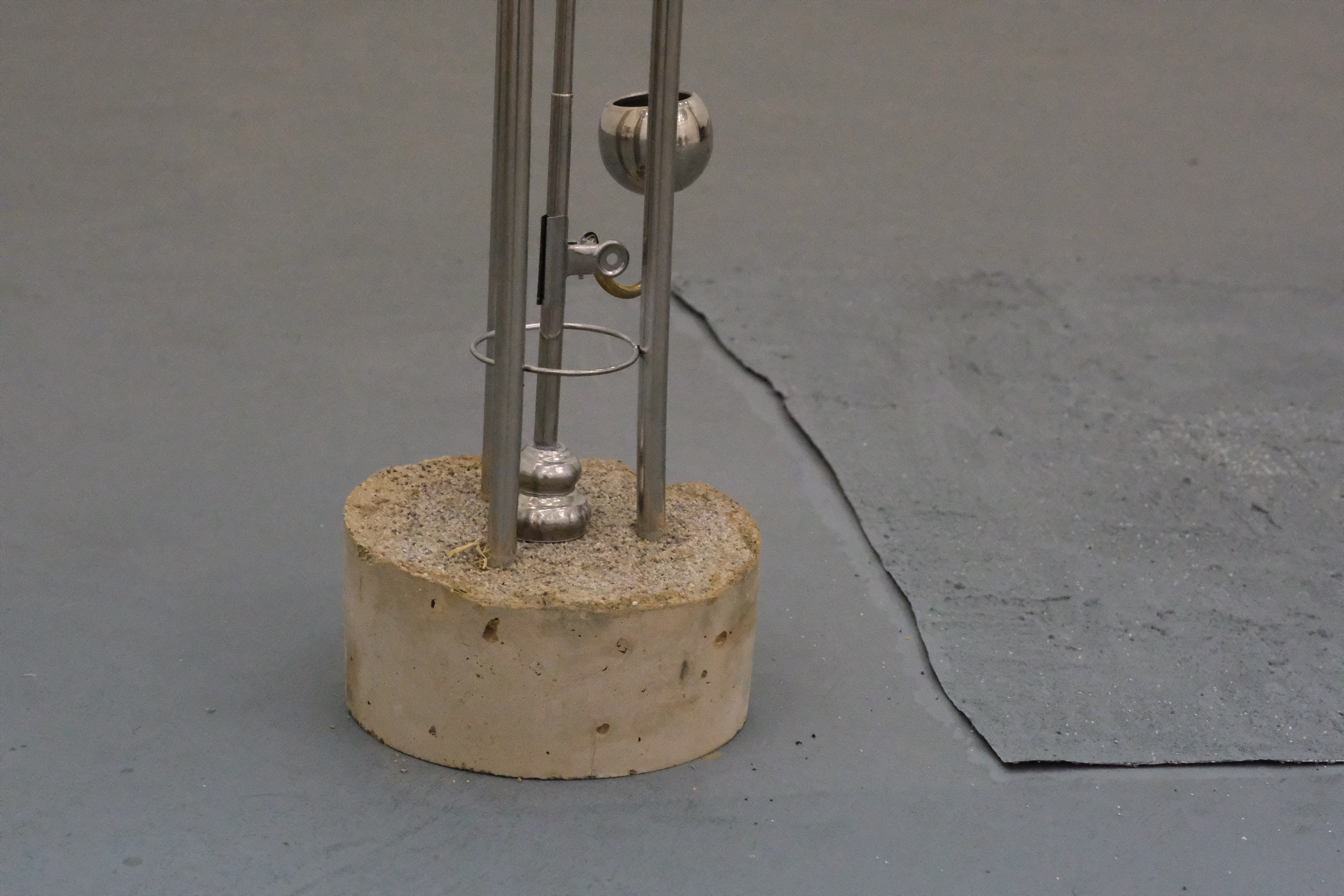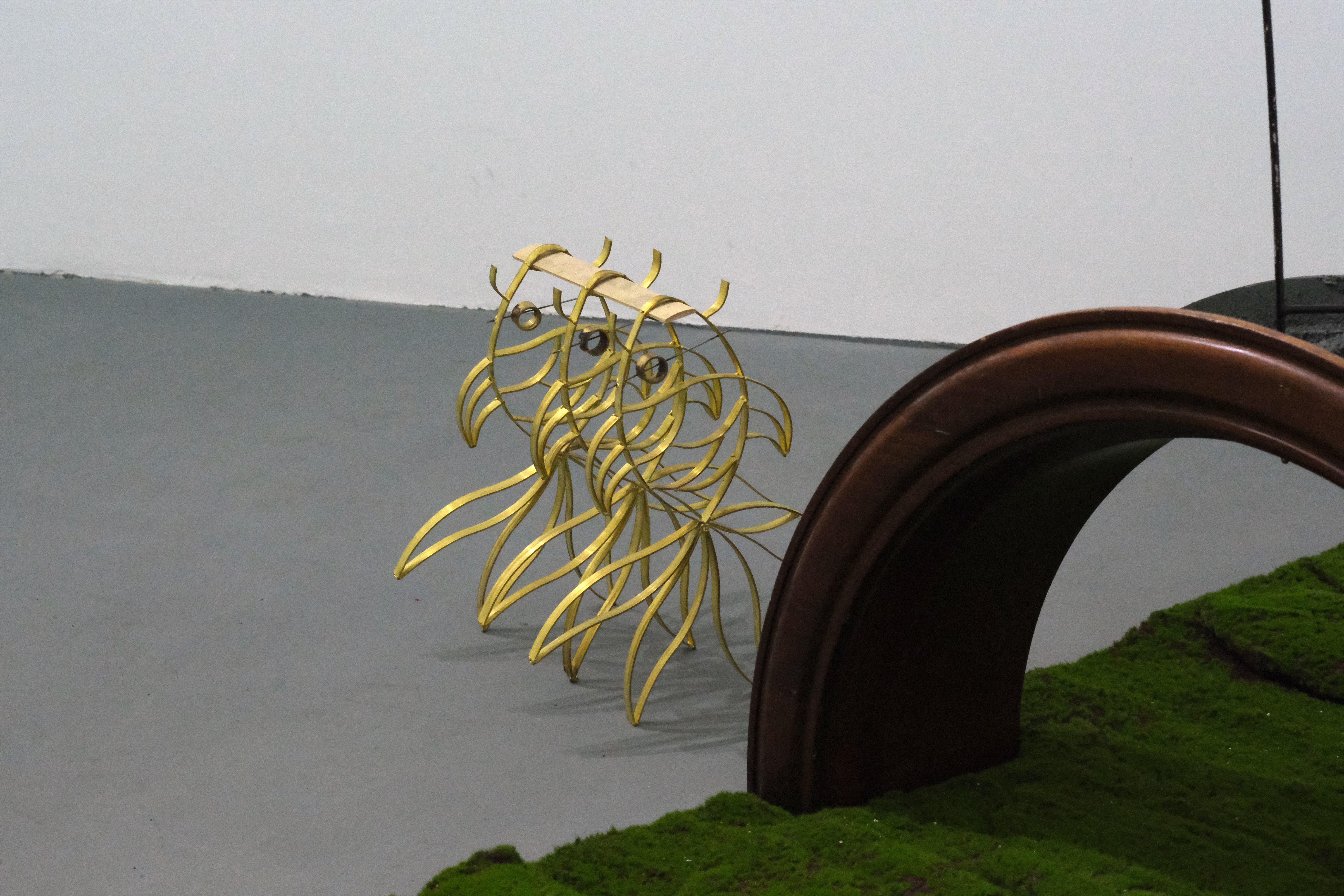沼泽小巫
2021
我时常想象一种由空间孕育的神奇生物。这个生物更像是一个精灵,和螺女或是座敷童子不同, 她不被期于任何功效,不会打扫房间或兴旺家宅,她只会在有限的空间里观察和游荡,是个名副其实没什么本事的“小巫”。有时她会化作橱柜里多出来的一只碗,或者复制墙上的裂纹。床铺, 窗棂,花盆,鸟笼,相框,这些无关紧要的,脆弱的,装饰性的容器和框架是她的课本。当房屋被毁掉,她就会离开,去到深林或云端。海市蜃楼是她记忆的反刍。
瑞典作家奥古斯特·斯特林堡在小说《By the Open Sea》中刻画了一个通过人工手段制造出蜃景的角色。为了使他的恋人高兴,他辛勤劳作了一个月,砍树挪土,在瑞典某座小岛上搭建出意大利托斯卡纳的地貌。在月光的掩饰下,幻像完美地倒映在海面,在场的所有人,包括他的恋人, 都为眼前的神迹所倾倒,将他视作“魔法师”。在创造幻象的同时,他自身也成为了幻象的延长。
我却对他的狂热充满了兴趣:陆上行舟,或许不是逃离,而是回溯。一条不关心,不追究,也不回避矛盾的回归线。我思考着现代空间如何与原始的感知相互渗透,相互完成。当物件以淡化逻辑的方式组成结构关系,是否可以投递出更接近原初印象中的生活体验?如果制造的目的本身就是为了编织谜语、营造幻象,那么复制品本身所蕴含的推测潜力是否可以连接比唯一真相/“真身” 更加庞大包容的所指?
Swamp Hut
2021
I often imagine a magical creature born from my room. Instead of performing tricks like cleaning the room or blessing the house, all she does is observing and wandering in her limited space. Sometimes she turns into an extra bowl in the cupboard, or mimics a crack on the wall. The insignificant, fragile, decorative containers like bed frame, window lattice, flower pot and bird cage become textbooks to her learning. When the house is destroyed, she leaves and vanishes into the forest or the clouds. The mirage is her reminiscence.
In his novel By the Open Sea, the Swedish writer August Strindberg portrays a character who creates a mirage through manmade endeavors. In order to please his lover, he labored for a month, cutting down trees and shifting great piles of earth to recreate a Tuscan landscape on a Swedish island. Under the cover of moonlight, the mirage was so perfect, captured at the precise moment when mirrored on the surrounding sea, that everyone present, including his lover, fell on their knees, amazed by the miracle in front of them. They began to call him the “mighty spirit”. While creating the illusion, he had become an extension of it.
But I was fascinated by his passion, a Fitzcarraldian determination perhaps not to run away, but to return. A line of regression that does not care, pursue, or avoid contradictions. I think about how modern space and primal perception permeate and complete each other. When objects form structural relationships in a way that dilutes logic, could they deliver an impression of life closer to the way we originally experience it? If the purpose of our fabrication is to tell riddles and create mirages, is it possible that the speculative potential allowed for in a copy could connect to something larger and more inclusive than the one truth/ original? Organhaus, Chongqing
2021
我时常想象一种由空间孕育的神奇生物。这个生物更像是一个精灵,和螺女或是座敷童子不同, 她不被期于任何功效,不会打扫房间或兴旺家宅,她只会在有限的空间里观察和游荡,是个名副其实没什么本事的“小巫”。有时她会化作橱柜里多出来的一只碗,或者复制墙上的裂纹。床铺, 窗棂,花盆,鸟笼,相框,这些无关紧要的,脆弱的,装饰性的容器和框架是她的课本。当房屋被毁掉,她就会离开,去到深林或云端。海市蜃楼是她记忆的反刍。
瑞典作家奥古斯特·斯特林堡在小说《By the Open Sea》中刻画了一个通过人工手段制造出蜃景的角色。为了使他的恋人高兴,他辛勤劳作了一个月,砍树挪土,在瑞典某座小岛上搭建出意大利托斯卡纳的地貌。在月光的掩饰下,幻像完美地倒映在海面,在场的所有人,包括他的恋人, 都为眼前的神迹所倾倒,将他视作“魔法师”。在创造幻象的同时,他自身也成为了幻象的延长。
我却对他的狂热充满了兴趣:陆上行舟,或许不是逃离,而是回溯。一条不关心,不追究,也不回避矛盾的回归线。我思考着现代空间如何与原始的感知相互渗透,相互完成。当物件以淡化逻辑的方式组成结构关系,是否可以投递出更接近原初印象中的生活体验?如果制造的目的本身就是为了编织谜语、营造幻象,那么复制品本身所蕴含的推测潜力是否可以连接比唯一真相/“真身” 更加庞大包容的所指?
Swamp Hut
2021
I often imagine a magical creature born from my room. Instead of performing tricks like cleaning the room or blessing the house, all she does is observing and wandering in her limited space. Sometimes she turns into an extra bowl in the cupboard, or mimics a crack on the wall. The insignificant, fragile, decorative containers like bed frame, window lattice, flower pot and bird cage become textbooks to her learning. When the house is destroyed, she leaves and vanishes into the forest or the clouds. The mirage is her reminiscence.
In his novel By the Open Sea, the Swedish writer August Strindberg portrays a character who creates a mirage through manmade endeavors. In order to please his lover, he labored for a month, cutting down trees and shifting great piles of earth to recreate a Tuscan landscape on a Swedish island. Under the cover of moonlight, the mirage was so perfect, captured at the precise moment when mirrored on the surrounding sea, that everyone present, including his lover, fell on their knees, amazed by the miracle in front of them. They began to call him the “mighty spirit”. While creating the illusion, he had become an extension of it.
But I was fascinated by his passion, a Fitzcarraldian determination perhaps not to run away, but to return. A line of regression that does not care, pursue, or avoid contradictions. I think about how modern space and primal perception permeate and complete each other. When objects form structural relationships in a way that dilutes logic, could they deliver an impression of life closer to the way we originally experience it? If the purpose of our fabrication is to tell riddles and create mirages, is it possible that the speculative potential allowed for in a copy could connect to something larger and more inclusive than the one truth/ original? Organhaus, Chongqing








